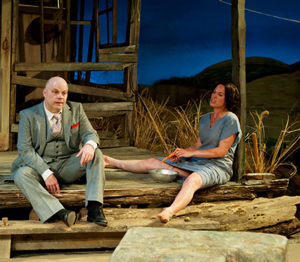
Realism in scenic design was a response to the formal wing-and-border stage decor of the 17th and 18th century, replacing artificial symmetry with more natural arrangements. The theaters of the 19th and early 20th century were much more spacious than those today, however—certainly larger than the 23 X 34-foot classroom in the Irish-American Heritage Center that houses the Seanachai Theatre Company's production of Eugene O'Neill's 1947 classic, A Moon For The Misbegotten. So how did co-designers Ira Amyx and Merje Veski come to employ such antiquated technology as canvas backdrops and walls angled in forced perspective?
"From the beginning, [director] Kevin [Theis] made it clear that he envisioned our production style as realism," Amyx assures me, "The design within that vision came from Merje and me. We developed a scheme with the crooked house and shed to reflect a drab, impoverished depression-era farm, but then we mixed in some warmer colors—the rose-colored inside walls, for example, and the blue-and-red door-frames—to hint at the sensitive humanity found in the characters who lived there."
Most theaters nowadays use slide-projections to fill in vast landscapes. Did you consider these? "Projections were never in the conversation. In a space that size, with subject matter that thoughtful, they'd stick out horribly."
Was it hard finding artists with experience at painting the old-fashioned drops? "Merje is an expert scene-painter. From the time she was young, she has worked on a wide range of theater projects and now on films and television all over the country."
The set also includes a number of real-life weeds and cornstalks, harvested from the shrubbery bordering the nearby highway. How do you keep this fragile flora from getting damaged during the course of the play? "Not without some trial and error!" Amyx laughs, "The 'flora' adds to the geography of the earth—making a flat floor look not flat is one of the most difficult illusions to pull off—so we placed the weeds close to large structures where the actor-traffic is less likely to disturb them."
What was the hardest part of designing this play? "The space was definitely the biggest challenge," Amyx recalls, "A store room entrance and the door leading to the dressing room are both right in the middle of the stage. Pulling off a believable perspective without masking essential sight lines was probably the most difficult task. Even though you don't want the set to be a distraction, it is still, itself, a living organism."
A Moon For The Misbegotten runs through April 29 at Seanachaí Theatre in the Irish-American Heritage Center.
Mary Shen Barnidge
Contributing Writer

 Follow Us On Twitter
Follow Us On Twitter